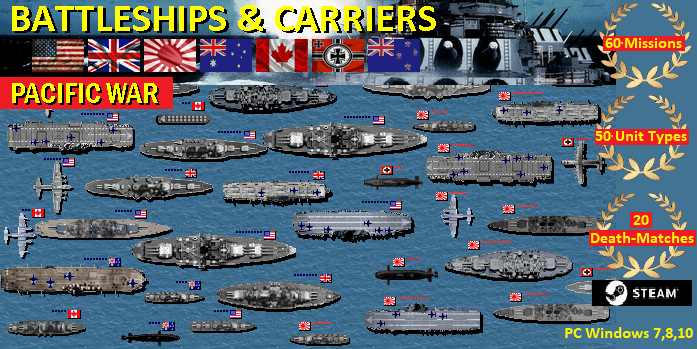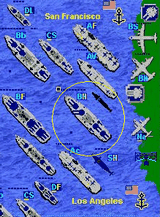See
also:
Battleship Game - WW2
Naval Strategy: No1 Battleship Game for PC and No3 Aircraft Carrier Game on World Net
Missions and Scenarios:
Pearl Harbor Game
Atlantic Game 1943
Sink Cruisers Game
Midway Game
Iwo Jima Game
US Marines Game
Luftwaffe Game Pacific
Torpedo Game Boats
Bismarck Game Pacific
Destroy RAF Game
Okinawa
Us Navy Submarine Game
Fleet Submarines Game
Kamikaze Game
U Boat Game
Singapore Game
Swordfish Hunt
Patrol Boats
Air Supremacy
Alert
Battleships Game
Java
Defense
Fleet Cruisers Game
Atlantic Island
Coral Sea Game
Iron Sea
Mykonos
Imperial Ocean
Long Convoy
Skagerrak
Target Los Angeles
West Pacific Game
Pacific War Game
Leyte Transport
Emperor Hirohito
Normandy Game
South Pacific Game
Destroy USAF Game
Submarine Games
US Navy Game
Free Hunt Doenitz Game
Free Hunt Spruance Game
Free Hunt Halsey Game
Imperial Navy I
Royal Navy Game
Free Hunt Pearl Harbor Games
Midway II
Kriegsmarine I
Brisbane Convoy
Clear West Coast
Fall Of Australia
Battle For Leyte
Conquer Of Japan
HMAS Perth
Road To Okinawa
Orange Ports
Emperor Defense
Prince Of Wales
San Bernardino
Pacific Race
Heavy Duty
Tokio Express
Operation Sidney
Bomber Operation
Conquer Of Italy
Heavy Cruiser Game
Frigate Hunt
Santa Cruz
Lamansh Game
Azores Transport
Norway Convoy
Invasion
Grossadmiral
Norway Ports
Drang Nach Ost
Convoy Pk30
Ciano Defense
Sir John Tovey
Free Hunt Andrews
Germans On Pacific
Silent Hunt
Antigua
Return To Midway
Kriegsmarine Game II
Royal Air Force Game
F. Hunt Lancaster
Jamamoto Game
Free Hunt USN
Free Hunt Japan
Free Hunt RAAF
Free Hunt U Boat Game
Free Hunt Aircraft Carriers Game
Free Hunt Hawaii
Free Hunt Yamato Game
Free Hunt Iwo Jima Game
Free Hunt Pacific Game
Free Hunt Torpedos
Free Hunt Convoy
Free Hunt Germany
Free Hunt Germany II
Free Hunt Italy
Free Hunt Malaya
Free Hunt Subs Game
Free Hunt B-29 Game
Free Hunt USN 1944
Devil Island
Dragoon Carriers
|
F-4
Phantom II
The F4 Phantom II is a two-place (tandem), supersonic,
long-range, all-weather fighter-bomber built by McDonnell
Douglas Corporation. It was operated by the US Navy, the
USMC and later the USAF, from 1961 until 1995. It is
still in service with other nations.
Its primary mission capabilities are: long range,
high-altitude intercepts utilizing air-to-air missiles as
primary armament; a 20mm M61 Vulcan cannon as secondary
armament; long-range attack missions utilizing
conventional or nuclear weapons as a primary armament;
and close air support missions utilizing a choice of
bombs, rockets and missiles as primary armament. It was
one of the few aircraft types that have served in the US
Navy, USMC and USAF. It was one of the longest serving
military aircraft post-war.First
flown in May 1958, the Phantom II originally was
developed for U.S. Navy fleet defense and entered service
in 1961. The USAF evaluated it (as the F-110A Spectre)
for close air support, interdiction, and counter-air
operations and, in 1962, approved a USAF version. The
USAF's Phantom II, designated F-4C, made its first flight
on May 27, 1963. Production deliveries began in November
1963.
In its air-to-ground role the F4 can carry twice the
normal bomb load of a WW II B-17 Flying Fortress. USAF
F4s also flew reconnaissance and "Wild Weasel"
air-defence suppression missions. Phantom II production
ended in 1979 after over 5,000 had been built--more than
2,800 for the USAF, about 1,200 for the Navy and Marine
Corps, and the rest for friendly foreign nations.
In 1965 the first USAF Phantom IIs were sent to Vietnam.
Early versions (F-4A to F-4D) lacked any gun armament.
Coupled with the unreliability of the air-to-air missiles
AIM-7 Sparrow AIM-9 Sidewinder at the time, this major
drawback resulted in the aircraft loss after they ran out
of missiles. During the course of the Vietnam War, its
contemporaries, the MiG-19 and MiG-21, inflicted heavy
losses on the F-4s when the American aircrafts were
ambushed after returning from bombing assignments. This
prompted the USAF to introduce the F-4E variant, which
added a M61 Vulcan cannon in the nose of the aircraft,
below the radome.
This later version was the mainstay of the USAF Phantom
II forces and served with the air forces of many
countries including Australia, Greece, Israel, Iran,
Japan, Spain, South Korea, Turkey and West Germany. F-4E
did not serve in USN or USMC, but an improved variant of
F-4B, the F-4J replaced earlier Phantom II variants in
these services. F-4J lacked gun armament either.
The United Kingdom bought the aircraft for use with the
Royal Air Force and Fleet Air Arm; British versions were
fitted with the larger but more powerful Rolls-Royce Spey
engine and were designated F-4K. Fleet Air Arm Phantoms
were fitted with a telescoping front undercarriage leg
allowing the nose to be raised up high, the increased
angle of attack being necessary for catapult launches
from the small British carriers.
The last of the F-4s were retired from duty with the US
military in 1995; however the aircraft still sees use in
a training role, as a drone, and in service to other
nations. The UK retired its last Phantoms in 1993.
| CIA / KGB Operation
Game.
Run your own intelligence game. Travel around the
world and set up espionage game, trade with state
secrets, weapon systems, spy codes, WMD, hire
secretaries, agents, lawyers and soldiers,
establish secret agent stations, cells and bases
and search for criminals and politicians. Involve
in agent game. Game contains more than 40
missions including Nuclear Game, Cold War Game,
Secret Agent, CIA Games, USAF, Prime Minister,
RAF, Bin Laden, Sadam, KGB, Operations Iran… |
|
F4
Variants
F-4A, B, J, N and S
Variants for the U.S. Navy and the U.S. Marine
Corps. F-4B was upgraded to F-4N, and F-4J was
upgraded to F-4S.
F-110 Spectre, F-4C, D and E
Variants for the U.S. Air Force. F-4E introduced
an internal M61 Vulcan cannon. The F-4D and E
were the most numerously built, widely exported,
and also extensively used under the Semi
Automatic Ground Environment (SAGE) U.S. air
defense system.
F-4G Wild Weasel V
A dedicated SEAD variant for the U.S. Air Force
with updated radar and avionics, converted from
F-4E. The designation F-4G was applied earlier to
an entirely different U.S. Navy Phantom.
F-4K and M
Variants for the Royal Navy and Royal Air Force,
respectively, re-engined with Rolls-Royce Spey
turbofans.
F-4EJ
Simplified F-4E exported to and license-built in
Japan.
F-4F
Simplified F-4E exported to Germany.
QRF-4C, QF-4B, E, G, N and S
Retired aircraft converted into remote-controlled
target drones used for weapons and defensive
systems research by USAF and USN / USMC.
RF-4B, C, and E
Tactical reconnaissance variants. |
General
Characteristics:
Primary Function: All-weather fighter-bomber.
Contractor: McDonnell Aircraft Co., McDonnell
Corporation.
Power Plant: Two General Electric J79 turbojet engines
with afterburners.
Thrust: 17,900 pounds (8,055 kilograms).
Length: 62 feet, 11 inches (19.1 meters).
Height: 16 feet, 5 inches (5 meters).
Wingspan: 38 feet, 11 inches (11.8 meters).
Speed: More than 1,600 mph (Mach 2.5).
Ceiling: 60,000 feet (18,182 meters).
Maximum Takeoff Weight: 62,000 pounds (27,900 kilograms).
Range: 1,300 miles (1,130 nautical miles).
Armament: Four AIM-7 Sparrow and four AIM-9 Sidewinder
missiles, AGM-65 Maverick missiles, AGM-88 HARM missile
capability, and one fuselage centerline bomb rack and
four pylon bomb racks capable of carrying 12,500 pounds
(5,625 kilograms) of general purpose bombs.
Cost: US$18.4 million
Crew: F-4E -- Two (pilot and electronic warfare officer).
Date Deployed: May 1963
Additional versions include:
F4-G "Wild Weasel" air defence suppresion.
RF-4C Tactical reconnaissance aircraft
QF-4 Drone, used for target vehicle
F-4 in USN
VF-121
"Pacemakers" at NAS Miramar became the first
Phantom operator with its F4H-1Fs (F-4As). The VF-74
"Be-devilers" at NAS Oceana became the first
deployable Phantom squadron when it received its F4H-1s
(F-4Bs) on 8 July 1961. The squadron completed carrier
qualifications in October 1961 and Phantom's first full
carrier deployment between August 1962 and March 1963
aboard Forrestal. The second deployable U.S. Atlantic
Fleet squadron to receive F-4Bs was the VF-102
"Diamondbacks", who promptly took their new
aircraft on the shakedown cruise of Enterprise. The first
deployable U.S. Pacific Fleet squadron to receive the
F-4B was the VF-114 "Aardvarks", which
participated in the September 1962 cruise aboard USS
Kitty Hawk.
By the time of the Tonkin Gulf incident, 13 of 31
deployable navy squadrons were armed with the type. F-4Bs
from Constellation made the first Phantom combat sortie
of the Vietnam War on 5 August 1964, flying bomber escort
in Operation Pierce Arrow. The first Phantom air-to-air
victory of the war took place on 9 April 1965 when an
F-4B from VF-96 "Fighting Falcons" piloted by
Lieutenant (junior grade) Terence M. Murphy and his RIO,
Ensign Ronald Fegan, shot down a Chinese MiG-17
"Fresco". The Phantom was then shot down,
probably by an AIM-7 Sparrow from one of its wingmen.
There continues to be controversy over whether the
Phantom was shot down by MiG guns or, as enemy reports
later indicated, an AIM-7 Sparrow III from one of
Murphy's and Fegan's wingmen. On 17 June 1965, an F-4B
from VF-21 "Freelancers" piloted by Commander
Louis Page and Lieutenant John C. Smith shot down the
first North Vietnamese MiG of the war.
On 10 May 1972, Lieutenant Randy "Duke"
Cunningham and Lieutenant William P. Driscoll flying an
F-4J, call sign "Showtime 100", shot down three
MiG-17s to become the first American flying aces of the
war. Their fifth victory was believed at the time to be
over a mysterious North Vietnamese ace, Colonel Nguyen
Toon, now considered mythical. On the return flight, the
Phantom was damaged by an enemy surface-to-air missile.
To avoid being captured, Cunningham and Driscoll flew
their burning aircraft using only the rudder and
afterburner (the damage to the aircraft rendered
conventional control nearly impossible), until they could
eject over water.
The Blue Angels flew the F-4J, 1969–74
During the war, U.S. Navy F-4 Phantom squadrons
participated in 84 combat tours with F-4Bs, F-4Js, and
F-4Ns. The Navy claimed 40 air-to-air victories at a cost
of 73 Phantoms lost in combat (seven to enemy aircraft,
13 to SAMs, and 53 to AAA). An additional 54 Phantoms
were lost in mishaps.
In 1984, the F-4Ns had been retired, and by 1987 the last
F-4Ss were retired in the U.S. Navy deployable squadrons.
On 25 March 1986, an F-4S belonging to the VF-151
"Vigilantes," became the last active duty U.S.
Navy Phantom to launch from an aircraft carrier, in this
case, Midway. On 18 October 1986, an F-4S from the VF-202
"Superheats", a Naval Reserve fighter squadron,
made the last-ever Phantom carrier landing while
operating aboard America. In 1987, the last of the Naval
Reserve-operated F-4S aircraft were replaced by F-14As.
The last Phantoms in service with the Navy were QF-4
target drones operated by the Naval Air Warfare Center at
NAS Point Mugu, California. These airframes were
subsequently retired in 2004
|
F4 In Germany
The German Air Force (Luftwaffe) initially ordered the
reconnaissance RF-4E in 1969, receiving a total of 88
aircraft from January 1971. In 1982, the initially
unarmed RF-4Es were given a secondary ground attack
capability; these aircraft were retired in 1994.
McDonnell RF-4E Phantom II of the Luftwaffe's AKG52 unit
in 1977
In 1973, under the "Peace Rhine" program, the
Luftwaffe purchased the F-4F (a lightened and simplified
version of the F-4E) which was upgraded in the mid-1980s.
24 German F-4F Phantom IIs were operated by the 49th
Tactical Fighter Wing of the USAF at Holloman AFB to
train Luftwaffe crews until December 2004. In 1975,
Germany also received 10 F-4Es for training in the U.S.
In the late 1990s, these were withdrawn from service
after being replaced by F-4Fs.[98] Germany also initiated
the Improved Combat Efficiency (ICE) program in 1983. The
110 ICE-upgraded F-4Fs entered service in 1992, and were
expected to remain in service until 2012. All the
remaining Luftwaffe Phantoms were based at Wittmund with
Jagdgeschwader 71 (fighter wing 71) in Northern Germany
and WTD61 at Manching. Phantoms were deployed to NATO
states under the Baltic Air Policing starting in 2005,
2008, 2009, 2011 and 2012. The German Air Force retired
its last F-4Fs on 29 June 2013. German F-4Fs flew 279,000
hours from entering service on 31 August 1973 until
retirement.
| |
|
| |
 |
| |
 |
| |
Turn-based WW2
naval game, extension to the classic
Submarine game (Battleship game) where
ships/planes/subs can move. Contains plenty of
game missions, game campaigns and 40 ship,
submarine, airplane ana port artillery types,
with combat maps up to 96X96 large. |
| |
|
| |
 |
| |
 |
| |
Guns Girls
Lawyers Spies is a turn-based strategy trade
management game. You'll build your
multinational spy company, destroy competition,
hire employees, spies, and businessman, establish
spy cells, bases and objects.
There is a more than 40 missions with different
game objectives. |
| |
|
| |
|
| |
 |
| |
Tycoon Strategy
Game - build your own world business empire as an
arms dealer tycoon. Travel around the world,
trade with more than 400 weapon systems, hire
secretaries, bodyguards, lawyers, fighters and
tanks, establish companies and search for
criminals and hostages. |
| |
|
|





